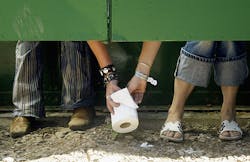Waterless toilet may help combat human waste in public
One great thing about how far we’ve come in the world of plumbing is how much it helps prevent disease across the world, particularly with our well –developed system here at home. However, not everyone is lucky enough to have access to plumbing at all times. This is why we were glad to see an article in The New York Times by Allison Arieff, as it shows how some cities are trying to give more people access to clean showers and toilets.
San Francisco, one of many major metropolitan cities in the U.S. with a sizeable homeless problem, has seen a Public Toilet Project Masterplan launched Hyphae Design Lab. While Arieff said the company certainly can’t totally solve homelessness, they are trying to create solutions to problems that stem from people living in public.
The Tenderloin Public Toilet Project (better known as the PPlanter), created by Hyphae Design Laboratory through a participatory design process, is one. It’s a cheap and mobile street urinal with sink that doubles as a planter and was built for $2,000. (As an added bonus in this drought-plagued state, the urine collected, after being filtered, is used to water the plants.) PPlanter underwent a test phase in 2103 and a second version is currently set up at a truck stop and a community outreach center in West Oakland.
The goal is still to provide this Tenderloin project as a free service, but as Hyphae’s Brent Bucknum explains, long-term maintenance continues to be the major hurdle in funding new models of urban sanitation.
Bucknum told Arieff that in order to solve this issue, they’ll need to have money earmarked for this as a public service or have a “pay as you go” mode, but as of yet, it is still new territory for urban areas.
Visit The New York Times’ website to read more from Arieff on these new public toilets and even showers on wheels. Do you think this could help solve the problem of public waste and hygiene?
